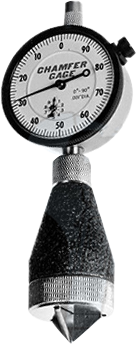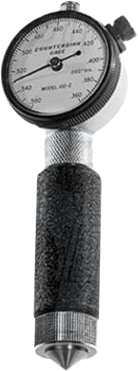When should a person choose a countersink gage over a chamfer gage? Ultimately they do the same thing: Both types of Gages utilize a plunger and special ratio indicator to measure the top diameter of a tapered/countersink bore.
But…there is more to the story. This article will explain the basic advantages and disadvantages of both types of gages.
Chamfer Gage

A Chamfer Gage has a 3 blade plunger that covers a range of angles 0-90° or 90-127° through a specific range of diameters in up to 1” increments. See table
GUARANTEED ACCURACY:
within ± .001" in 0°-90° models
within ± .002" in 90°-127° models
Analog Indicator: .001" graduation
(+) Relatively long range and versatile.
(-) Long range = an indicator with a rev counter. You will need to count the revs on a dial chamfer gage to calculate your reading.
(+) you can “set” a Chamfer Gage on any good, flat surface (a surface plate, gage block, face of a ring gage) to master the gage. If desired, a special sharp-edge setting ring made close to the I.D. to be measured for higher accuracy can be used.
Note: The plunger of the Chamfer Gage is not sharp. If it was, it would become dull over time and throw off the “setting” of the gage. To compensate for the truncated plunger, a preset number is located on the back of the gage. This number should be verified to read on the dial face when the Chamfer Gage plunger is pushed flush to the datum surface to set the gage. Since the Chamfer gage (and Countersink Gage for that matter) are in fact depth gages that rely on the form of the plunger to give an accurate diameter, if the plunger is damaged or worn, your measurements will be off!
(-) Since the Chamfer Gage covers a wide range of diameters you will not have as sure of a “fit” into the bore as you would with a countersink gage
Countersink Gage

A Countersink Gage has a solid cone (under normal circumstances) ground to an exact angle that measures a specific range of countersink diameters in approximately .200” increments. See table
GUARANTEED ACCURACY:
± .0005" or ± .015mm
Analog Indicator: .002" graduation
(+) Analog/Dial countersink gages are 1 rev, direct read, so there no need to count revolutions on the indicator. That is convenient!
(-) Since the measuring range of the dial indicator is relatively small on an analog Countersink Gage, you cannot master the gage on a flat surface to set the gage. A sharp-edge ring gage must be used. These are included with the analog models.
Note: This is not the case for a digital Countersink Gage which has a much larger range on the indicator. A setting ring is not needed to set the gage.
(+) Although the Countersink Gage is designed to give you the top I.D. of the bore, you are not only checking the top ID with a Countersink Gage but also you are checking the form (angle) of the countersink at the same time. If there is some problem with the actual countersink itself, you will get a bad reading for the I.D. In a sense, you are getting 2 measurements for the price of one! Form and diameter.
Note: Could you use a Chamfer Gage to get the top diameter of a Countersink Bore? The answer is yes. However, the Countersink Gage checks Countersink Angle and Diameter at the same time and the Chamfer Gage will not check the angle because it’s plunger only contacts at the very top of the bore.
(-) Since the countersink gage is dedicated and has short range compared to the chamfer gage, you will need to purchase a lot of them if you have a big range of countersinks to measure.
The major diameter of a taper is a function of the angle, by controlling the major diameter you are in effect controlling the angle.
However, you have to use the COUNTERSINK GAGE which has the exact angle on the Gaging Plunger. This is why in the Aerospace Industry the COUNTERSINK GAGE is more widely used. They are more interested in knowing the angle is OK than knowing what exactly the angle is. By employing an exact angle Gaging Plunger, the gage would only give the correct major diameter if the angle was correct. Otherwise the reading would be off. If you used a CHAMFER GAGE which has a 0º-90º or 90º to 127º Gaging Plunger you could get a top diameter reading which would be within the tolerance BUT would not be able to determine if the angle below was correct. This is why it is important to have a matching angle on the Gaging Plunger."
If you any questions on this subject contact us, or leave a comment below!

1 Comments
Leave a Comment
Leave a Reply